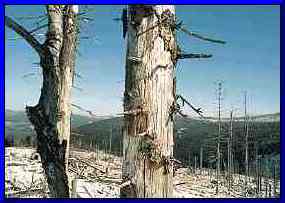Problems........
Unfortunately, as with the majority of chemical reactions, combustion of gasoline is not 100% effective and so this incomplete combustion leads to the production of several other gases in addition to water vapour and carbon dioxide.
The most dangerous of these gases include carbon monoxide since this can combine with haemoglobin preventing the uptake of oxygen. Oxides of nitrogen are also formed in the combustion chamber where nitrogen and oxygen combine to yield NO and NO2:
N2
(g) + O2 (g) ![]() 2NO (g)
2NO (g)
2NO(g) + O2
(g) ![]() 2NO2 (g)
2NO2 (g)
Acid Rain:
These nitrogen oxides catalyse the oxidation of SO2 to SO3 which then reacts with water in the atmosphere to form sulphuric acid or acid rain.:
SO3
(g) + H2O (l) ![]() H2SO4 (l)
H2SO4 (l)
The sulphuric acid eventually reaches
the ground as rain, snow or mist with disastrous effects on the environment
since it disrupts the roots of vegetation, burns the leaves of trees therefore
preventing them from photosynthesising as well as acidifying lakes and water
reserves leading to destruction of
aquat ic
life.
ic
life.
Picture illustrating the effect on vegetation
Courtesy of USGS
Photochemical smog:
In addition to the problem of acid rain, emissions from the combustion of gasoline and other fossil fuels can lead to the formation of photochemical smog. This occurs via a photochemical reaction between the gases such as NOx and HOx and sunlight leading to a mixture of ozone, VOCs (volatile organic compounds) and other gases.
Global warming:
Ozone production is a major consequence of fossil fuel burning, the VOCs compete with O3 for the available HO2 yielding the following cycle of reactions:
1) CO + OH ![]() H + CO2
H + CO2
2) H + O2 + M ![]() HO2 + M
HO2 + M
3) HO2 + NO ![]() NO2 + OH
NO2 + OH
The NO2 is then photolysed to yield ground state oxygen atoms which can then combine to form ozone, O3 molecules:
4) NO2 + hv
![]() NO + O(3P) + O2 img width=39
height=12 src="problemsxxx_files/image004.gif">
NO + O(3P) + O2 img width=39
height=12 src="problemsxxx_files/image004.gif">
5) O(3P) + O2 + M ![]() O3 + M
O3 + M
Since ozone is a greenhouse gas, the increase in Ozone concentration in the trophosphere (below 20Km), stratosphere (below 50km), mesosphere (below 85km) and thermosphere (above 85km) will result in greater re-absorption of infra-red radiation back down tot he Earth's surface hence the great concerns over global warming.
 The figure to the left summarises the processes by which infrared
radiation is trapped by natural greenhouse gases. An increase in Ozone will
effectively multiply this natural process yielding a warmer climate although the
detailed and localised effects are complex and still not fully understood.
The figure to the left summarises the processes by which infrared
radiation is trapped by natural greenhouse gases. An increase in Ozone will
effectively multiply this natural process yielding a warmer climate although the
detailed and localised effects are complex and still not fully understood.